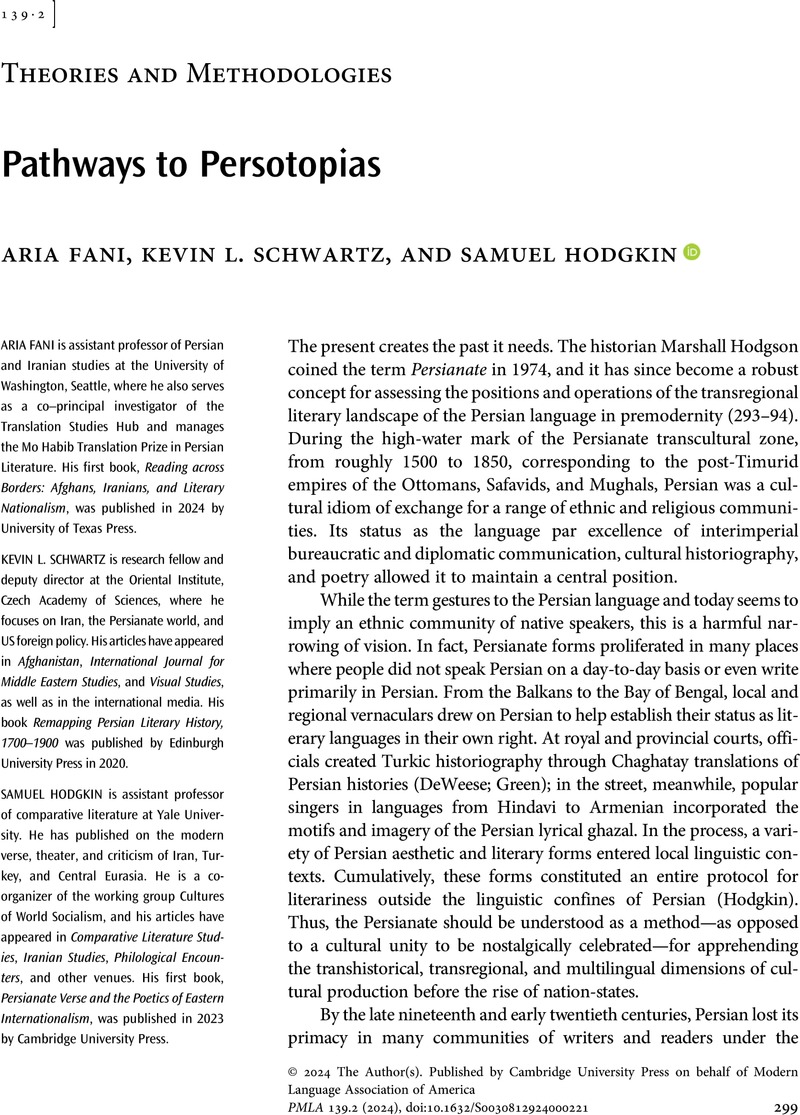No CrossRef data available.
Article contents
Pathways to Persotopias
Published online by Cambridge University Press: 26 July 2024
Abstract
An abstract is not available for this content so a preview has been provided. Please use the Get access link above for information on how to access this content.

- Type
- Theories and Methodologies
- Information
- Copyright
- Copyright © 2024 The Author(s). Published by Cambridge University Press on behalf of Modern Language Association of America
References
Works Cited
Abedinifard, Mostafa, et al., editors. Persian Literature as World Literature. Bloomsbury Publishing, 2021. Literatures as World Literature Series.CrossRefGoogle Scholar
Ahmed, Shahab. What Is Islam? The Importance of Being Islamic. Princeton UP, 2015.CrossRefGoogle Scholar
Anam, Nasia, editor. Forms of the Global Anglophone. Post45, post45.org/sections/contemporaries-essays/global-anglophone/. Accessed 10 Oct. 2023.Google Scholar
Balpe, Jean-Pierre. “Pour une littérature informatique: Un manifeste . . . .” Littérature et informatique: La littérature générée par ordinateur, edited by Vuillemin, Alain and Lenoble, Michel, Artois PU, 1995, pp. 19–32.Google Scholar
DeWeese, Devin. “Persian and Turkic from Kazan to Tobolsk: Literary Frontiers in Muslim Inner Asia.” The Persianate World: The Frontiers of a Eurasian Lingua Franca, edited by Green, Nile, U of California P, 2019, pp. 131–55.Google Scholar
Elkin, Lauren. “The End of Francophonie: The Politics of French Literature.” The White Review, June 2011, www.thewhitereview.org/feature/the-end-of-francophonie-the-politics-of-french-literature-2/.Google Scholar
Elling, Rasmus Christian. Minorities in Iran: Nationalism and Ethnicity after Khomeini. Palgrave Macmillan, 2013.CrossRefGoogle Scholar
Fani, Aria. “One Tongue, No Tongue: ‘Return’ and Afghan-Iranian Dialogue.” Frontline: Tehran Bureau, 13 May 2012, www.pbs.org/wgbh/pages/frontline/tehranbureau/2012/05/poetry-one-tongue-no-tongue-return-and-its-story-of-cultural-dialogue.html.Google Scholar
Fani, Aria. Reading across Borders: Afghans, Iranians, and Literary Nationalism. U of Texas P, 2024.CrossRefGoogle Scholar
Fani, Aria, and Schwartz, Kevin L.. Introduction. Persianate Pasts; National Presents: Persian Literary and Cultural Production in the Twentieth Century, special issue of Iranian Studies, edited by Fani and Schwartz, vol. 55, 2022, pp. 605–09.CrossRefGoogle Scholar
Green, Nile. “The Frontiers of the Persianate World (ca. 800–1900).” Introduction. The Persianate World: The Frontiers of a Eurasian Lingua Franca, edited by Green, U of California P, 2019, pp. 1–71.Google Scholar
Hodgkin, Samuel. “The Poetics of Persianate Disaffiliation: Recusative Gestures for a Royal Genre.” Philological Encounters, vol. 8, no. 2, 2023, pp. 281–304.CrossRefGoogle Scholar
Hodgson, Marshall. The Venture of Islam: The Expansion of Islam in the Middle Periods. Vol. 2, U of Chicago P, 1974.CrossRefGoogle Scholar
Ismailov, Hamid. بزم اهریمن [Bazm-e ahriman]. Translated by Parisa Rahmati, Entesharat-e ketab-sara-ye nik, 1402 [2023].Google Scholar
Ismailov, Hamid. Bizkim—kompyuterlar; yo, dunyoning eng gözal shoiri: Ghazal shaklidagi roman. Telegram, 2022.Google Scholar
Ismailov, Hamid. Interview with the authors. Hotel Don Giovanni, Prague, Czech Republic, 6 Sept. 2023.Google Scholar
Kazemi, Mohammad Kazem. بازگشت [“Bazgasht”]. 1991. Radio Zamaneh, 25 Apr. 2012, www.radiozamaneh.com/42747/.CrossRefGoogle Scholar
Kazemi, Mohammad Kazem. Interview with the authors. Telegram, 25 July–13 Sept. 2023.Google Scholar
Kazemi, Mohammad Kazem. کلید در باز [Kelid-e dar-e baz]. Nashr-e sureh, 2009.Google Scholar
Laachir, Karima, et al. “Multilingual Locals and Significant Geographies: For a Ground-Up and Located Approach to World Literature.” Modern Languages Open, vol. 1, no. 19, 2018, pp. 1–8.Google Scholar
Migraine-George, Thérèse. From Francophonie to World Literature in French: Ethics, Poetics, and Politics. U of Nebraska P, 2013.CrossRefGoogle Scholar
Nölle-Karimi, Christine, et al., editors. Literary Modernity in the Persophone Realm: A Reader. Austrian Academy of Sciences, forthcoming.Google Scholar
Olszewska, Zuzanna. “‘A Desolate Voice’: Poetry and Identity among Young Afghan Refugees in Iran.” Iranian Studies, vol. 40, no. 2, 2007, pp. 203–24.CrossRefGoogle Scholar
Schwartz, Kevin L. “The Local Lives of a Transregional Poet: ʻAbd al-Qāder Bidel and the Writing of Persianate Literary History.” Journal of Persianate Studies, vol. 9, 2016, pp. 83–106.CrossRefGoogle Scholar
Schwartz, Kevin L. Remapping Persian Literary History, 1700–1900. Edinburgh UP, 2020.CrossRefGoogle Scholar
Thornber, Karen Laura. Empire of Texts in Motion: Chinese, Korean, and Taiwanese Transculturations of Japanese Literature. Harvard UP, 2009. Harvard-Yenching Institute Monographs 67.Google Scholar




